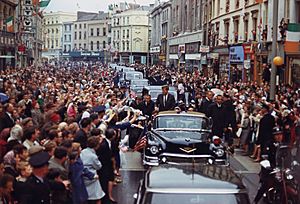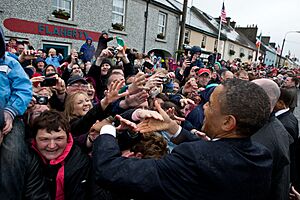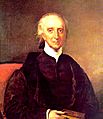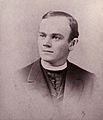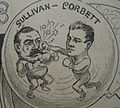Irish Americans facts for kids
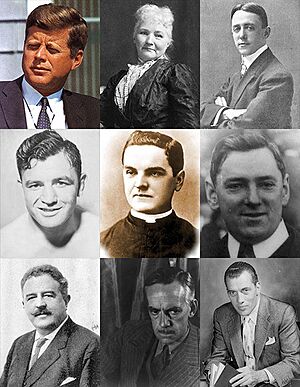
John F. Kennedy, Mother Jones, George M. Cohan
James Braddock, Michael J. McGivney, J.M. Curley
Victor Herbert, Eugene O'Neill, Ed Sullivan.
Irish Americans are people in North America whose families came from Ireland. They are American citizens whose ancestors were Irish.
Contents
Who are Irish Americans?
People are called Irish Americans if:
- Their family came from any part of Ireland, including the Republic of Ireland or Northern Ireland.
- They moved to the United States from Ireland and became American citizens.
History of Irish Americans
Most Irish people came to the United States between the 1600s and the mid-1800s.
The largest number of Irish people arrived in the United States between 1820 and 1860. During this time, one out of every three people who moved to the United States was Irish.
Between 1820 and 1860, almost 2 million Irish people came to the United States. About 1.5 million of them came after the Great Famine of 1845-1852. This terrible time is also called The Great Hunger. Many Irish people died while trying to travel to America on crowded ships.
From 1820 to 1930, about 4.5 million Irish people moved to the United States.
Where did Irish immigrants live?
Most Irish people who came to the United States in the 1800s lived in big cities. They often settled where many other Irish people already lived. This helped them support and protect each other. Many stayed near the ports where they arrived, like Boston, New York City, San Francisco, and Los Angeles. Many Irish people also lived in Chicago, Philadelphia, Detroit, St. Louis, Pittsburgh, and Baltimore.
Facing unfair treatment
Most Irish immigrants who came to America in the 1800s were Catholic. At that time, many people in the United States were Protestants. These differences sometimes led to unfair treatment.
Many Irish immigrants were treated badly. For example:
- Some places did not give jobs to Irish Americans.
- Newspapers often used stereotypes to describe Irish people.
- Many Americans believed that Irish people were not as smart as other Americans. They thought Irish people did not deserve to be true citizens.
Some politicians spoke out against Irish people. For example, in 1836, Benjamin Disraeli wrote that some people thought the Irish were "wild" and "lazy."
In the mid-1950s, a political group called the Know-Nothing Movement tried to get Catholic politicians fired from their jobs. Stereotypes about Irish Americans continued for a long time.
Irish Americans today
In 2013, about 33.3 million Americans said they had some Irish family history. This is about one in every 10 Americans. It is also about seven times the number of people who actually live in Ireland today.
American presidents with Irish family
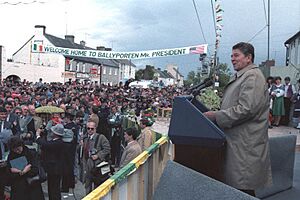
Many presidents of the United States have Irish family roots. Some presidents had parents or grandparents born in Ireland, while others had more distant Irish family.
- John F. Kennedy (35th president, 1961–1963): He was the first Irish Catholic president. His family came from Limerick and County Wexford.
- Richard M. Nixon (37th president, 1969–1974): His family came from County Kildare in 1729. Nixon visited his family's old home in 1972.
- Ronald Reagan (40th president, 1981–1989): His father's family came from County Tipperary in the 1840s.
- Barack Obama (44th president, 2009–2017): Some of his mother's family came from a small village called Moneygall, in County Offaly.
- Joe Biden (46th and current president, 2021–present): He has strong Irish family roots. Ten of his 16 great-great-grandparents were born in Ireland. His family came from County Mayo and County Louth.
Other presidents with Irish family include:
- Andrew Johnson (17th president, 1865–69)
- William Howard Taft (27th president, 1909–13)
- Woodrow Wilson (28th president, 1913–1921)
- Grover Cleveland (22nd and 24th president, 1885–89 and 1893–97)
- Ulysses S. Grant (18th president, 1869–77)
- George H. W. Bush (41st president, 1989–1993)
- George W. Bush (43rd president, 2001–2009)
Vice presidents with Irish family
- Mike Pence (48th vice president 2017–2021)
Speakers of the U.S. House of Representatives with Irish family
The Speaker of the House is a very important leader in the United States government. Many Speakers have had Irish family roots:
- Joseph W. Martin Jr. (1947–1949 & 1953–1955)
- John W. McCormack (1962–1971)
- Tip O'Neill (1977–1987)
- Jim Wright (1987–1989)
- Tom Foley (1989–1995)
- John Boehner (2011–2015)
- Paul Ryan (2015–2019)
Irish-American justices of the Supreme Court
The Supreme Court is the highest court in the United States. These justices have had Irish family:
- Joseph McKenna
- Edward D. White
- Pierce Butler
- Frank Murphy
- James Francis Byrnes
- William J. Brennan
- Anthony Kennedy
- Neil Gorsuch
- Brett Kavanaugh
- Amy Coney Barrett
Images for kids
-
Charles Carroll of Carrollton, the only Catholic person to sign the U.S. Declaration of Independence. His family came from County Tipperary.
-
"Leacht Cuimhneacháin na nGael", an Irish famine memorial in Philadelphia.
-
Gravestone in a Boston Catholic cemetery for someone born in County Roscommon before the Great Famine.
-
U.S. President Grover Cleveland in a cartoon from Puck magazine.
-
The Orange riot of 1871 in Manhattan, New York.
-
Irish immigrants in Kansas City, Missouri, around 1909.
-
A New York Times advertisement from 1854 that said "NINA" (No Irish Need Apply) for men.
-
St. Patrick's Cathedral in New York City.
-
The logo of the Boston Celtics basketball team.
-
The Philadelphia Phillies baseball team started wearing green uniforms on St. Patrick's Day.
-
Actor Tom Cruise has Irish family roots from County Dublin.
-
An Irish Republican mural in South Boston, Massachusetts.
-
The Chicago River, dyed green for the 2005 St. Patrick's Day celebration.
See also
 In Spanish: Inmigración irlandesa en los Estados Unidos para niños
In Spanish: Inmigración irlandesa en los Estados Unidos para niños


